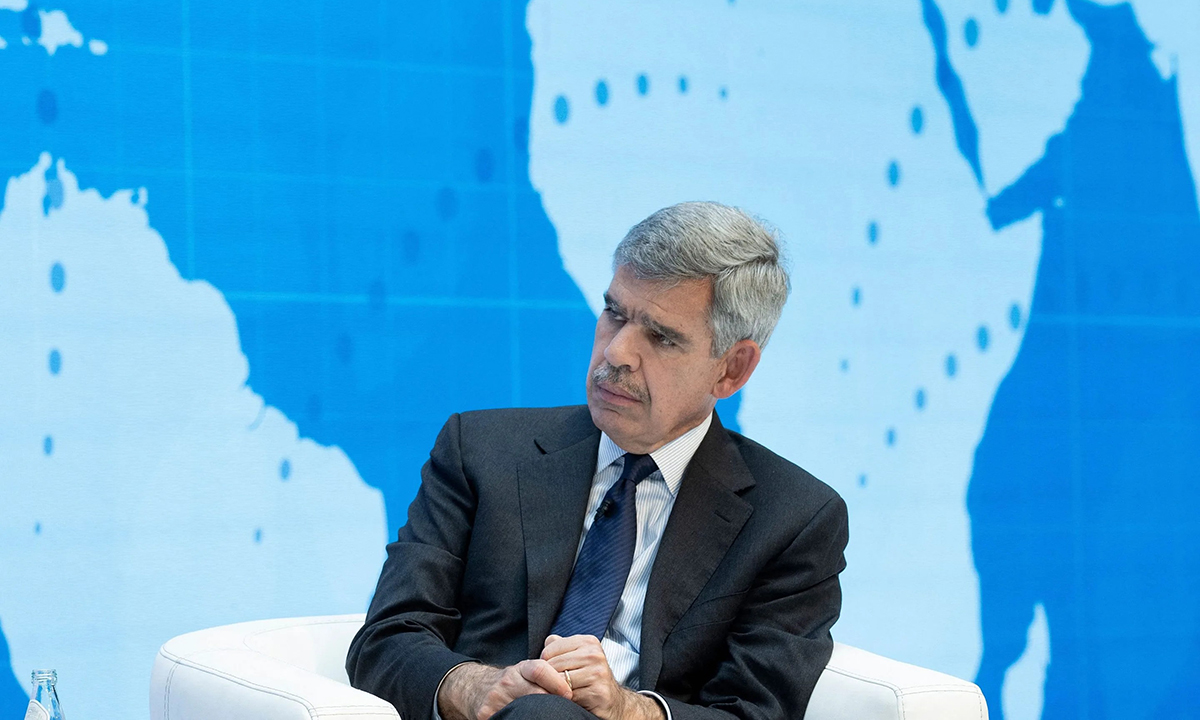
美国11月的就业报告超出预期,这当然值得庆祝,而且大多数美国人确实感到庆幸。但由于通货膨胀始终接近四十年最高水平,因此对于美联储而言情况却截然不同。
美联储官员今年已经六次加息,试图给经济降温,将通胀降低到2%的目标水平,但到目前为止,他们只是减慢了消费物价上涨速度。
一些经济学家认为,最新的就业报告证明,美联储的措施力度不足以按照预期平衡劳动力市场,这意味着通货膨胀可能难以应付。
剑桥大学(University of Cambridge)皇后学院(Queens’ College)院长穆罕默德·埃里安周末对微软全国广播公司(MSNBC)表示:“本周的数据只是表明,美联储依旧行动过晚,力度不足。通货膨胀问题依旧顽固。虽然通胀确实在下降,但下降速度不足。”
11月,美国经济新增26.3万个就业岗位,失业率接近疫情之前的最低水平3.7%。工资同比上涨5.1%,环比上涨0.6%,为自1月以来的最快涨幅。
虽然这对于美国上班族而言是好消息,但美联储一直希望工资上涨速度能够放缓,失业率能够小幅上升,以协助其抑制通胀。埃里安警告称,在11月份的就业报告中有证据暴露出劳动力市场的“供应问题”可能刺激了通货膨胀。
他提到劳动力参与率下降的趋势时称:“未来前景黯淡。”劳动力参与率是指参与工作或积极找工作的人口比例。
上个月,劳动力参与率从疫情之前的63.4%下降至62.1%,在2000年的最高点曾超过67%。由于空缺岗位的竞争者减少,因此劳动力市场紧张可能持续更长时间,这会导致通胀恶化。
埃里安认为,最新就业报告表明,美联储官员需要保持鹰派立场,否则他们可能会重蹈疫情期间的覆辙:低估通货膨胀的持久力,导致美国陷入经济衰退。
他表示:“想象一下你正开车在高速公路上行驶,你应该减速,高速公路变得越来越危险……前方有浓雾笼罩。去年,他们就应该减速,但他们并没有这样做。他们向我们保证这是暂时的;浓雾终究会消散。但事实上并没有。”埃里安在批评美联储的政策措施时,将浓雾比作通货膨胀。
埃里安表示,现在美联储正在用力刹车,利用快速加息控制通货膨胀(走出“迷雾”),但这些措施依旧无效,这意味着美国经济未来将经历更多痛苦。
他说道:“我们已经连续四次加息0.75个百分点;这是史上前所未有的。虽然美联储已经踩下刹车,但汽车并未快速减速。他们试图令美国经济进一步减速。如果他们尽早采取行动,就能减少对经济的不必要损害。很可惜,现在木已成舟。”(财富中文网)
翻译:刘进龙
审校:汪皓
美国11月的就业报告超出预期,这当然值得庆祝,而且大多数美国人确实感到庆幸。但由于通货膨胀始终接近四十年最高水平,因此对于美联储而言情况却截然不同。
美联储官员今年已经六次加息,试图给经济降温,将通胀降低到2%的目标水平,但到目前为止,他们只是减慢了消费物价上涨速度。
一些经济学家认为,最新的就业报告证明,美联储的措施力度不足以按照预期平衡劳动力市场,这意味着通货膨胀可能难以应付。
剑桥大学(University of Cambridge)皇后学院(Queens’ College)院长穆罕默德·埃里安周末对微软全国广播公司(MSNBC)表示:“本周的数据只是表明,美联储依旧行动过晚,力度不足。通货膨胀问题依旧顽固。虽然通胀确实在下降,但下降速度不足。”
11月,美国经济新增26.3万个就业岗位,失业率接近疫情之前的最低水平3.7%。工资同比上涨5.1%,环比上涨0.6%,为自1月以来的最快涨幅。
虽然这对于美国上班族而言是好消息,但美联储一直希望工资上涨速度能够放缓,失业率能够小幅上升,以协助其抑制通胀。埃里安警告称,在11月份的就业报告中有证据暴露出劳动力市场的“供应问题”可能刺激了通货膨胀。
他提到劳动力参与率下降的趋势时称:“未来前景黯淡。”劳动力参与率是指参与工作或积极找工作的人口比例。
上个月,劳动力参与率从疫情之前的63.4%下降至62.1%,在2000年的最高点曾超过67%。由于空缺岗位的竞争者减少,因此劳动力市场紧张可能持续更长时间,这会导致通胀恶化。
埃里安认为,最新就业报告表明,美联储官员需要保持鹰派立场,否则他们可能会重蹈疫情期间的覆辙:低估通货膨胀的持久力,导致美国陷入经济衰退。
他表示:“想象一下你正开车在高速公路上行驶,你应该减速,高速公路变得越来越危险……前方有浓雾笼罩。去年,他们就应该减速,但他们并没有这样做。他们向我们保证这是暂时的;浓雾终究会消散。但事实上并没有。”埃里安在批评美联储的政策措施时,将浓雾比作通货膨胀。
埃里安表示,现在美联储正在用力刹车,利用快速加息控制通货膨胀(走出“迷雾”),但这些措施依旧无效,这意味着美国经济未来将经历更多痛苦。
他说道:“我们已经连续四次加息0.75个百分点;这是史上前所未有的。虽然美联储已经踩下刹车,但汽车并未快速减速。他们试图令美国经济进一步减速。如果他们尽早采取行动,就能减少对经济的不必要损害。很可惜,现在木已成舟。”(财富中文网)
翻译:刘进龙
审校:汪皓
November’s stronger-than-expected jobs report should be cause for celebration, and it is for most Americans. But with inflation sitting near a four-decade high, it’s a different story for the Federal Reserve.
Fed officials have raised interest rates six times this year in an attempt to cool the economy and reduce inflation to their 2% target rate, but so far they’ve managed only to slow the pace of consumer price increases.
And some economists say the latest jobs report is evidence that the Fed’s policies haven’t done enough to balance the labor market as intended—which means inflation could be sticky.
“If anything, this week’s numbers suggest that the Fed is still doing too little, too late,” Mohamed El-Erian, the president of Queens’ College at the University of Cambridge, told MSNBC over the weekend. “Inflation remains a problem. Yes, it’s coming down, but it’s not coming down fast enough.”
The U.S. economy added 263,000 jobs, and the unemployment rate stuck near pre-pandemic lows at 3.7% in November. Wages also rose 5.1% from a year ago and 0.6% month over month—the fastest pace since January.
While this is good news for American workers, the Fed has been hoping the pace of wage increases would slow and unemployment would mildly increase to aid its inflation fight. El-Erian warned that there is evidence of “supply issues” in the labor market in November’s jobs report that could boost inflation as well.
“There are clouds on the horizon,” he said, pointing to the falling labor force participation rate—the percentage of the population that works or is actively seeking work.
The labor force participation rate dropped to 62.1% last month, from 63.4% prior to the pandemic—it peaked at over 67% in the year 2000. With fewer workers competing for open positions, the labor market could remain tighter for longer, exacerbating inflation.
El-Erian argued that the latest jobs report shows Fed officials need to remain hawkish, otherwise they could commit the same error that they did during the pandemic era: underestimating the staying power of inflation, leading to a U.S. recession.
“Think of it as if you’re driving on the freeway and you should be slowing down, the freeway is getting more treacherous…there’s fog on the horizon,” he said, equating fog to inflation as he described the Fed’s policy error. “Last year, they should have slowed down, but they didn’t. They assured us that this was transitory; the fog was going to lift. Well, it didn’t lift.”
Now, El-Erian said, the Fed is slamming on the brakes with rapid rate hikes to fight inflation (get out of the “fog”), and it’s still not working, which means Americans will experience even more economic pain moving forward.
“We’ve had four consecutive 0.75 percentage point [interest rate] increases; that’s never happened in history before. Having hit the brakes, the car hasn’t slowed down enough,” he said. “They’re trying to slow us down even more. Had they started earlier, there would be less undue damage to the economy. But unfortunately, we are where we are.”






